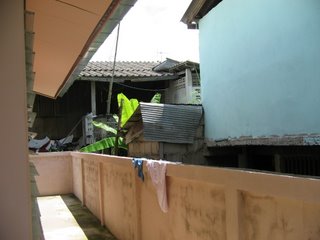


"How about a giraffe? What sound does a giraffe make?"
"I don’t think a giraffe makes a sound."
"A penguin? That can’t make a very fun sound. How about a beaver?"
"A beaver probably makes a sound like this: (gnaw and cluck with front teeth sticking out)."
"Yeah! That’s good for a beaver. They’ll like that. What else?"
"Does a llama make a sound?"
"That llama on Sesame Street used to make a squealing sound, but it wasn’t very pleasant."
"How about if it sort of snorts and spits? A llama might do that. But then the kids might all start spitting instead of singing..."
"Maybe if we do the llama last, then the song will be almost over anyway, so they won’t have a lot of time to spit."
(Pause)
"Can you believe this is our dinner table conversation?"
"Yeah, why did I bother learning the Library of Congress catalog system, writing a thesis on Quebec’s Quiet Revolution, and studying Foucault’s theories of post-modernism in history?"
If you had been a gecko on the wall around 6:30pm in our pink house, as I was clearing the dishes and Robert was finishing off his pad si iew (stir-fried noodles with soy sauce), you would have heard an extended version of the above conversation. It took place at the end of the first of two days of the English camp we are running for 6th graders at 5 schools in our town. There are 129 students, divided into 8 groups, with each group represented by an animal that lives primarily outside southeast Asia.*
The camp is actually a science and English camp, with 8 different stations. Our four English stations include Animals Around the World, Landforms, Weather, and Conservation. To liven up the Weather station a little, we selected vocabulary words like "typhoon" and "blizzard" instead of "rain" and "snow".
Overall, the first day went well. The teachers enjoyed their stations, and the kids said they were having fun. We’re trying to liven a few activities up for tomorrow, though, and the snippet of conversation above is part of our attempt to map out "Old MacDonald Had a Zoo" for the morning’s opening song.
One highlight of my day, unrelated to spitting llamas, was discovering a bizarre Thai dessert that I actually liked. Usually I don’t like traditional Thai desserts, because they either a) are gelatinous in texture and come in colors like fluorescent pink and green, or b) have a meat filling, like pork or shrimp. There is a particular dessert, though, that is only partially gelatinous and comes in a nice shade of light brown that I don’t mind too much. Today I picked up a piece during the morning coffee break, but when I opened it I discovered that it had a new ingredient that made me nervous.
"Ajaan Wirinton," I said to the teacher working at the Conservation Station with me, "does this have any meat in it?" "No," she replied in a reassuring voice, "you can eat that!" Ajaan Dara came over and verified. "Thai desserts are usually just sugar and coconut milk, no meat!" they agreed. "That one just has some onions! It’s still vegetarian!"
"Right..." I thought, "just some onions. Exactly what I expect to find in my dessert!" But I took a bite, and what do you know, it was really good. So there you have it: sugar, coconut milk, and crispy fried onions: a surprisingly tasty treat.
*The animals, in addition to giraffes, penguins, beavers, and llamas, include kangaroos, woodpeckers, hippos, and camels.
And yes, Robert really did make the commend about Foucault’s theories, etc.




















